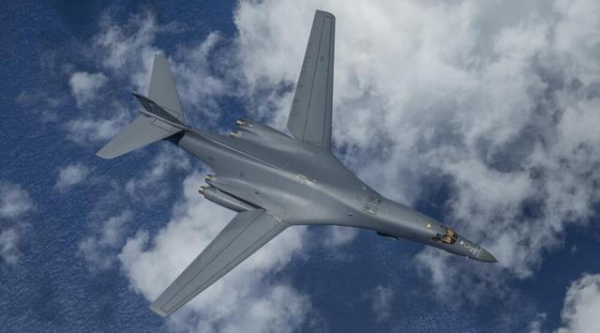
The US Navy, which has blundered big time in the prevention and control of the COVID-19 pandemic, reported on April 23 infections on 40 military vessels, which made up 1/7 of US's existing vessels. Against such a background, the US Navy and Air Force's reconnaissance planes have flown over the Taiwan Strait at a much higher frequency recently. On May 4, two B-1B supersonic strategic bombers flew to the East China Sea and appeared over waters off Taiwan for the first time. What are they up to?
It's known to all that ever since the US labeled China as an important strategic competitor in Trump's first National Security Strategy released in December 2017, the Pentagon has intensified its efforts to provoke, deter and curb China. It has not only based over 60% of its naval and air forces in the Indo-Pacific region, but has also had a more active engagement in West Pacific affairs.
However, the unexpected COVID-19 outbreak, especially the US becoming the global epicenter, has upset the Pentagon's deployments. In particular, all four American nuclear-powered aircraft carriers in the Asia Pacific were forced to stop operation due to confirmed COVID-19 cases, and the absence of those core strengths of America's global deployments and strike led to a huge vacuum in frontier waters of West Pacific, resulting in a complete disappearance of US original aggressive offensive and defensive stance.
In such a context, the US has more frequently sent military aircraft to the airspace over the West Pacific Ocean and the Taiwan Strait for the following considerations.
First of all, the US wants to demonstrate its military presence in the key region of Asia Pacific in the fastest and most convenient way. At the forefront of the West Pacific particularly, it hopes to find, as soon as possible, one or two combat platforms or large weapons that can substitute aircraft carriers or amphibious assault ships to some extent. That's the primary goal for Pentagon decision-makers since the outbreak.
As a result, the US Navy and Air Force have joined hands in the attempt to replace large and medium-sized surface warships with multiple types of aircraft since March. Incomplete statistics show that the US military assigned reconnaissance planes, assisted by anti-submarine patrol planes, to conduct 11 overflights and air patrols around Taiwan and above the South China Sea in March. More air force reconnaissance planes were used in April, which, along with its naval aircraft, flew over the region 13 times.
Second, the US wants to back up some people in Taiwan amid the pandemic while accomplishing its own tactical tasks.
The US military is perfectly aware of the tasks, reconnaissance approaches, and anti-submarine capabilities of its electronic surveillance aircraft and anti-submarine patrol aircraft. They are used to conducting close-in reconnaissance and spying on others. One of their main tasks is to detect the operations of submarines in the region, a task that can only be performed by US aircraft as most of its surface vessels in the Pacific Fleet have been suspended. Besides, Washington also intends to give some confidence to certain forces in Taiwan by telling them that the US hasn't given up its regional military presence because of the pandemic and is still able to send aircraft there even if their vessels are suspended.
Third, the US wants to show China its determination to maintain strategic deterrence in key regions.
The Pentagon knows that reconnaissance plane and the anti-submarine plane cannot fully demonstrate strategic deterrence, so it sent four B-1B strategic bombers and about 200 air force members from Texas to Andersen Air Force Base in Guam to replace the previous B-52H, and the new bombers flew close to the Taiwan Strait on May 4. The reason why the US made such adjustments is simple—B-1B has a larger payload, higher speed, and better stealth performance than B-52H. The decision-makers at Pentagon are obviously trying to use strategic bombers as a new tool to exert strategic deterrence against China. It's foreseeable that the US will probably send B-1B bombers more frequently to the airspace over the Taiwan Strait and the South China Sea in May.
Some are worried that the US may create another "aircraft collision over the South China Sea", or intentionally create frictions in sensitive regions around China, to deflect the domestic anger at the White House's poor response to the outbreak. Well, they have their reasons, and we have our preparations.
(The author is a researcher at the Naval Military Studies Research Institute)













